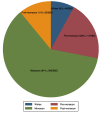Cholera Outbreaks in India, 2011-2020: A Systematic Review
- PMID: 35565133
- PMCID: PMC9099871
- DOI: 10.3390/ijerph19095738
Cholera Outbreaks in India, 2011-2020: A Systematic Review
Abstract
Fecal contamination of water sources and open defecation have been linked to cholera outbreaks in India. However, a systematic review on the drivers responsible for these outbreaks has yet to be published. Here, we systematically review the published literature on cholera outbreaks in India between 2011 and 2020. We searched studies in English in three databases (MEDLINE, EMBASE, and Web of Science) and the Integrated Disease Surveillance Program that tracks cholera outbreaks throughout India. Two authors independently extracted data and assessed the quality of the included studies. Quantitative data on the modes of transmission reviewed in this study were assessed for any change over time between 2011-2015 and 2016-2020. Our search retrieved 10823 records initially, out of which 81 full-text studies were assessed for eligibility. Among these 81 studies, 20 were eligible for inclusion in this review. There were 565 reported outbreaks between 2011 and 2020 that led to 45,759 cases and 263 deaths. Outbreaks occurred throughout the year; however, they exploded with monsoons (June through September). In Tamil Nadu, a typical peak of cholera outbreaks was observed from December to January. Seventy-two percent (33,089/45,759) of outbreak-related cases were reported in five states, namely Maharashtra, West Bengal, Punjab, Karnataka, and Madhya Pradesh. Analysis of these outbreaks highlighted the main drivers of cholera including contaminated drinking water and food, inadequate sanitation and hygiene (including open defecation), and direct contact between households. The comparison between 2011-2015 and 2016-2020 showed a decreasing trend in the outbreaks that arose due to damaged water pipelines. Many Indians still struggle with open defecation, sanitation, and clean water access. These issues should be addressed critically. In addition, it is essential to interrupt cholera short-cycle transmission (mediated by households, stored drinking water and foodstuffs) during an outbreak. As cholera is associated with deprivation, socio-economic development is the only long-term solution.
Keywords: India; behavioral changes; cholera; close contact; food; household; open defecation; outbreak; sewage; water supply.
Conflict of interest statement
The authors declare no conflict of interest.
Figures











Similar articles
-
Eliciting adverse effects data from participants in clinical trials.Cochrane Database Syst Rev. 2018 Jan 16;1(1):MR000039. doi: 10.1002/14651858.MR000039.pub2. Cochrane Database Syst Rev. 2018. PMID: 29372930 Free PMC article.
-
Sertindole for schizophrenia.Cochrane Database Syst Rev. 2005 Jul 20;2005(3):CD001715. doi: 10.1002/14651858.CD001715.pub2. Cochrane Database Syst Rev. 2005. PMID: 16034864 Free PMC article.
-
Measures implemented in the school setting to contain the COVID-19 pandemic.Cochrane Database Syst Rev. 2022 Jan 17;1(1):CD015029. doi: 10.1002/14651858.CD015029. Cochrane Database Syst Rev. 2022. Update in: Cochrane Database Syst Rev. 2024 May 2;5:CD015029. doi: 10.1002/14651858.CD015029.pub2. PMID: 35037252 Free PMC article. Updated.
-
A rapid and systematic review of the clinical effectiveness and cost-effectiveness of topotecan for ovarian cancer.Health Technol Assess. 2001;5(28):1-110. doi: 10.3310/hta5280. Health Technol Assess. 2001. PMID: 11701100
-
Interventions targeted at women to encourage the uptake of cervical screening.Cochrane Database Syst Rev. 2021 Sep 6;9(9):CD002834. doi: 10.1002/14651858.CD002834.pub3. Cochrane Database Syst Rev. 2021. PMID: 34694000 Free PMC article.
Cited by
-
Antibacterial action, proteolytic immunity, and in vivo activity of a Vibrio cholerae microcin.Cell Host Microbe. 2024 Nov 13;32(11):1959-1971.e6. doi: 10.1016/j.chom.2024.08.012. Epub 2024 Sep 10. Cell Host Microbe. 2024. PMID: 39260372
-
Biological Characterization and Evaluation of the Therapeutic Value of Vibrio Phages 4141 and MJW Isolated from Clinical and Sewage Water Samples of Kolkata.Viruses. 2024 Nov 6;16(11):1741. doi: 10.3390/v16111741. Viruses. 2024. PMID: 39599855 Free PMC article.
-
Complete genomic sequence of Vibrio fluvialis strain IDH5335 isolated from a patient with diarrhea in Kolkata, India.Microbiol Resour Announc. 2023 Dec 14;12(12):e0070723. doi: 10.1128/MRA.00707-23. Epub 2023 Nov 9. Microbiol Resour Announc. 2023. PMID: 37943041 Free PMC article.
-
Improving Water Quality Index Prediction Using Regression Learning Models.Int J Environ Res Public Health. 2022 Oct 21;19(20):13702. doi: 10.3390/ijerph192013702. Int J Environ Res Public Health. 2022. PMID: 36294286 Free PMC article.
-
Evidence of Antibiotic Resistance and Virulence Factors in Environmental Isolates of Vibrio Species.Antibiotics (Basel). 2023 Jun 16;12(6):1062. doi: 10.3390/antibiotics12061062. Antibiotics (Basel). 2023. PMID: 37370381 Free PMC article.
References
-
- Harris J.B., Khan A.I., LaRocque R.C., Dorer D.J., Chowdhury F., Faruque A.S.G., Sack D.A., Ryan E.T., Qadri F., Calderwood S.B. Blood Group, Immunity, and Risk of Infection with Vibrio cholerae in an Area of Endemicity. Infect. Immun. 2005;73:7422–7427. doi: 10.1128/IAI.73.11.7422-7427.2005. - DOI - PMC - PubMed
Publication types
MeSH terms
Substances
LinkOut - more resources
Full Text Sources
Medical
Research Materials

